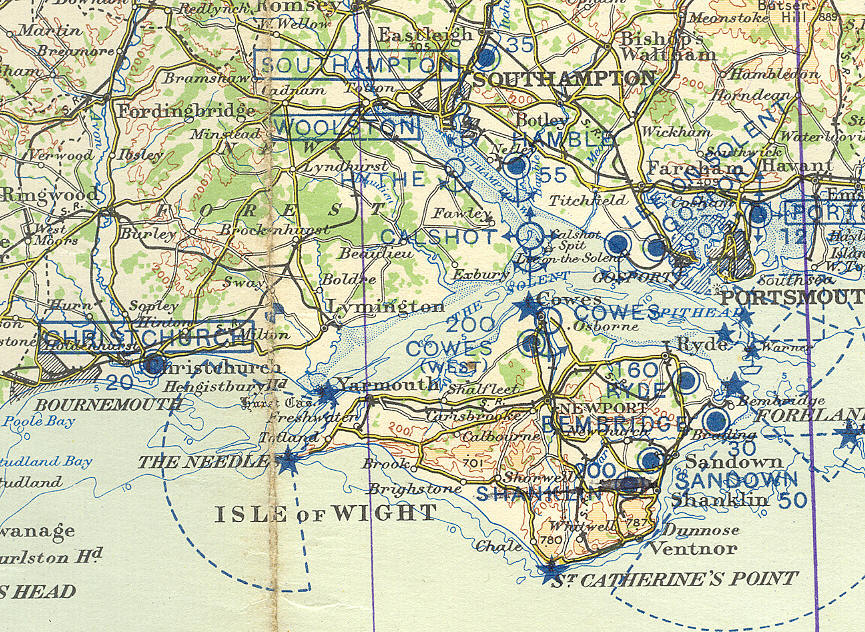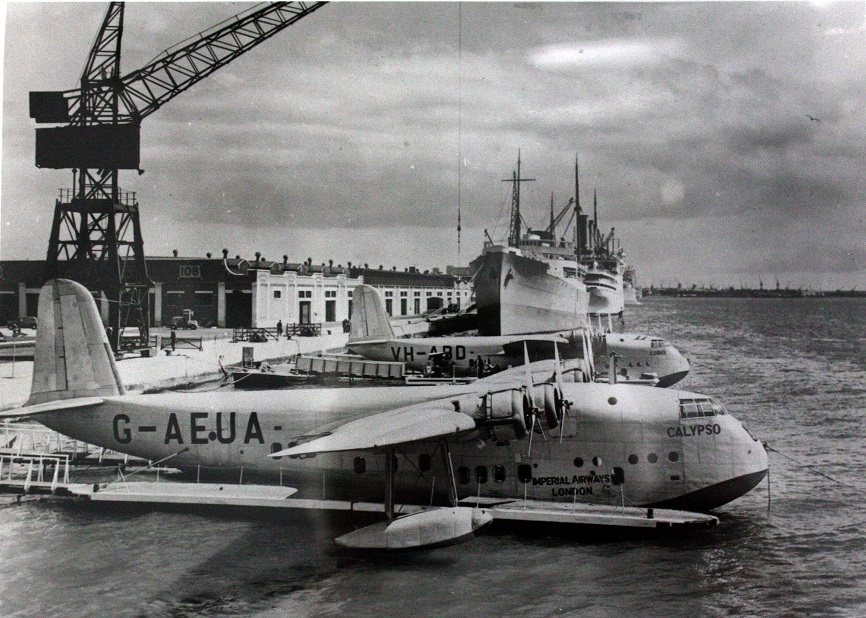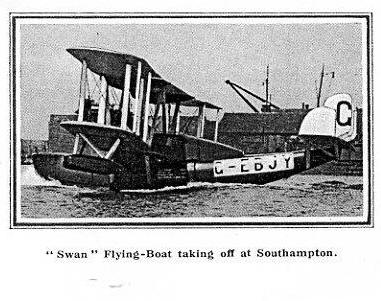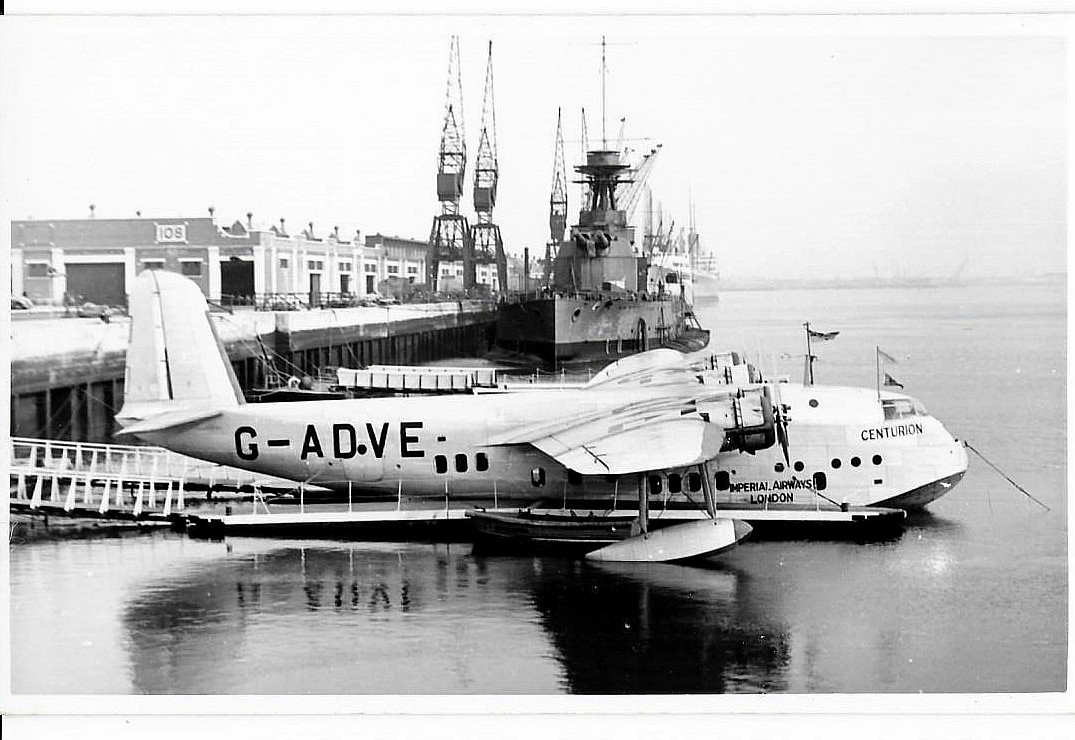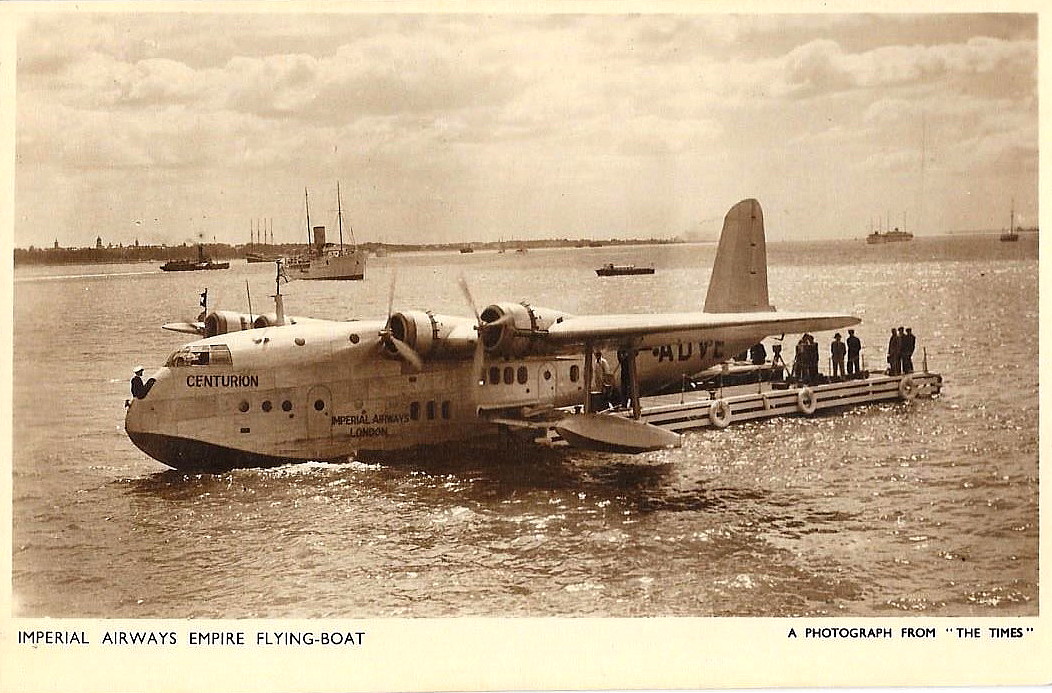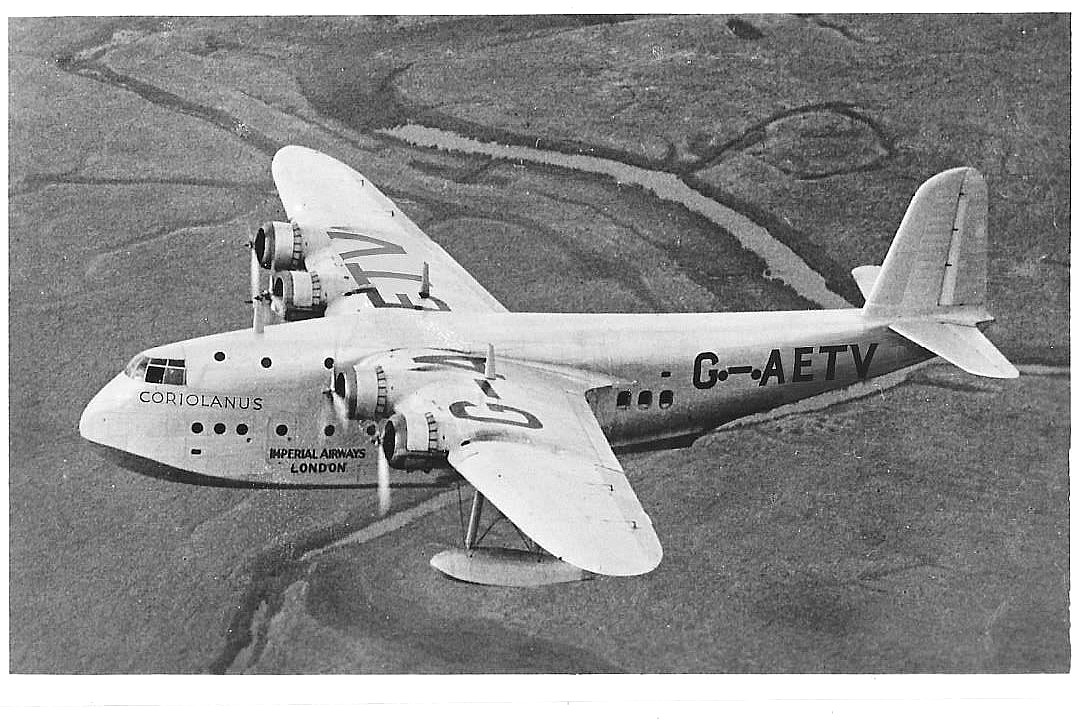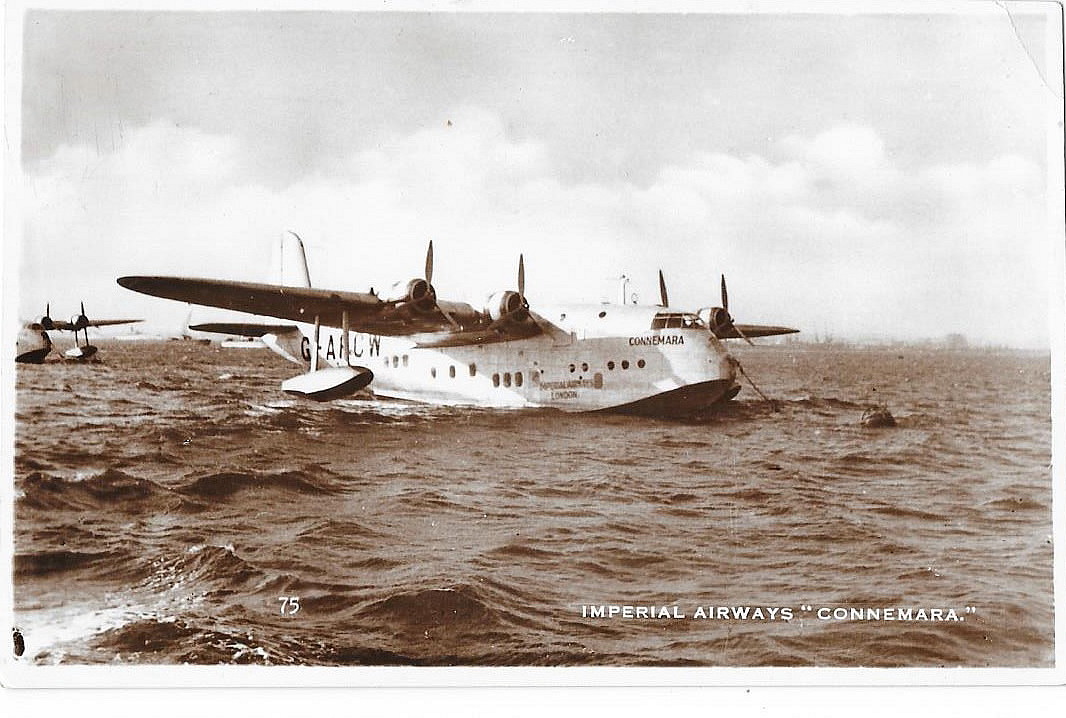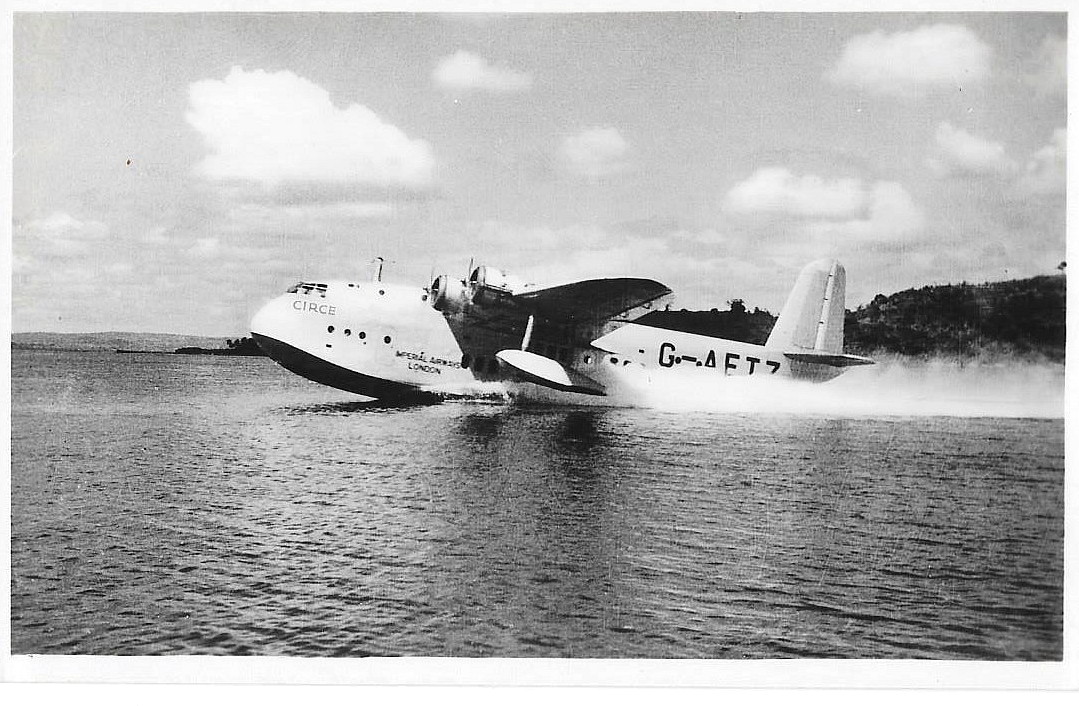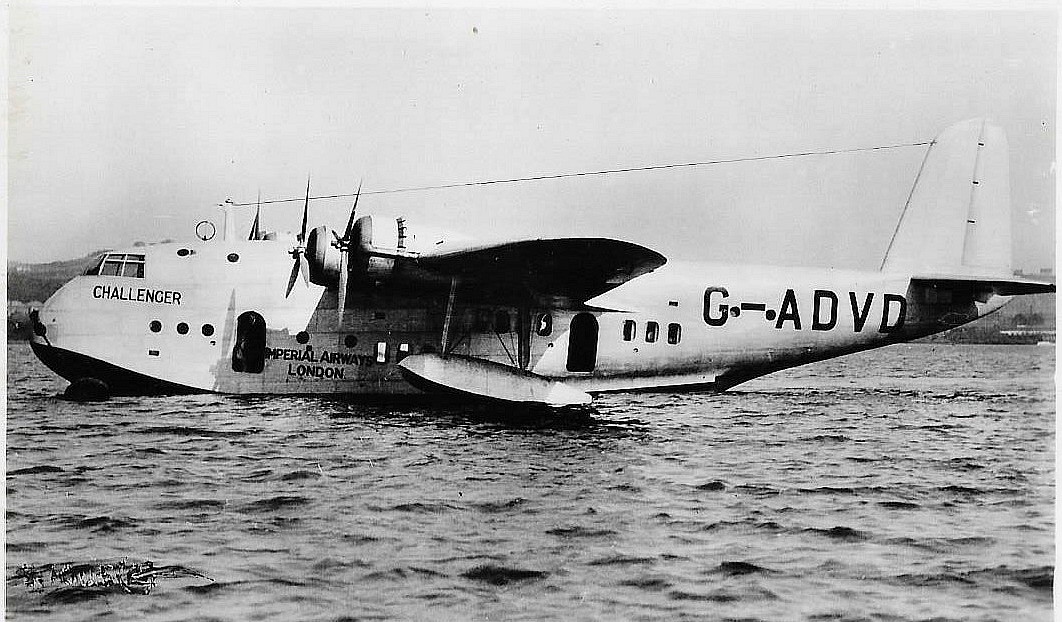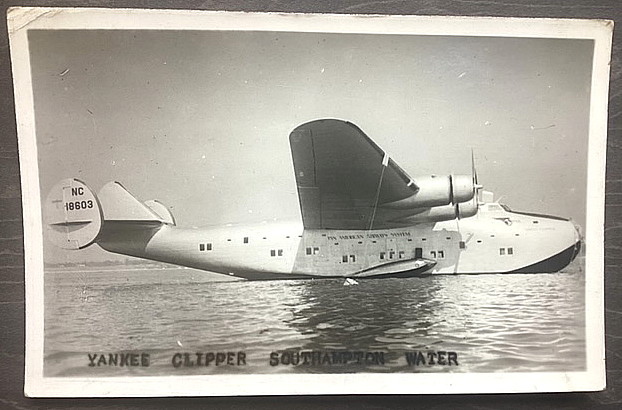Southampton Marine Airport
SOUTHAMPTON (Flying boats) see also ROYAL PIER
SOUTHAMPTON MARINE AIRPORT TERMINAL: Flying Boat Air Port
(Aka SOUTHAMPTON MARINE AIR TERMINAL)
Operated by: Imperial Airways
Location: In the River Itchen in Woolston, S of the Woolston ferry
Period of operation: 1923 to 1940 (Operation moved to Poole Harbour in DORSET during WW2)
Note: The really interesting aspect of this picture is that one of these 'C' Class flying boats is registered in Australia - and operated by QANTAS. According to most reports Imperial Airways handed over the Australian service to QANTAS in Singapore, (and possibly a couple of other Far East destinations?), so why was one of their flying boats in Southampton? Possibly at the start of a delivery flight perhaps and earning some useful revenue along the way?
NOTES: It seems the flying boats mostly took off and landed in Southampton Water (some say the Solent) and probably between CALSHOT and HYTHE? They then water-taxied up to the River Itchen.
Note. A bit of research into this 12-seat amphibious aircraft proved revealing. It first entered service in August 1924 and was withdrawn from service in January 1928. However, what intrigues me is that the registered owner was: 'The Air Council, Air Ministry, Kingsway, London WC2.' Can anybody today kindly explain these circumstances? I assume of course that The Air Council weren't operating the aircraft commercially?
This picture, kindly sent to me by Peter Marson in 2005, also had the following information: "The Marine Air Port of Southampton is situated on the Woolston bank of the River Itchen. Passengers arriving at Southampton by train can take a taxi or tram-car from outside the Station to the Floating Bridge, from which the Air Port will be easily seen. No car service is provided by the Company."
In September 1919 the Supermarine Company started regular services to Le Havre using a Supermarine Channel 1 G-EAED which was it is sometimes claimed, the first international commercial seaplane flight in the world, but is was a short lived venture. Starting in August 1923 the British Marine Air Navigation Co operated a Supermarine Sea Eagle flying boat (G-EBFK) from Southampton to Guernsey and Cherbourg but it seems doubtful the enterprise lasted more than one season? Both these operations appear to have used ROYAL PIER - see seperate entry.
A MIKE CHARLTON GALLERY
Note: This gallery of pictures from postcards, does I hope, give examples of Imperial Empire Class flying boats that once used this terminal. Mike Charlton has an amazing collection of aviation postcards - see: www.aviationpostcard.co.uk
First picture. The 29-seater Short S.23 Empire flying boat 'Centurion' G-ADVE was registered to Imperial on the 7th October 1935. Here again, another interesting aspect of aviation history. Shorts were registering their S.23 Empire flying boats several months before the first example flew. Proof it seems of just how confident they were that the type would be highly successful. The first flight of the S.23 was on the 3rd July 1936.
It sank after landing at Calcutta (India) on the 12th June 1939. The really odd thing about the official records, is that they state the 'Usual Station' for G-ADVE was ROCHESTER. Surely this cannot be correct?
Second picture: The 34-seater (modified from a 29-seater) Short S.23 Empire flying boat 'Canopus' G-ADHL was registered to Imperial on the 17th June 1935, and served until the 27th August 1940. Later known as a 'Hythe' type, it was operated by BOAC until the 12th November 1946 when it was broken up at HYTHE (HAMPSHIRE). But, here again, with both Imperial and BOAC its usual 'Station' was ROCHESTER (KENT). Could somebody kindly explain why this was?
Fourth picture: This picture of the 26-seater Short S.23 Empire 'Coogee' G-AEUG was taken at Basra, (Iraq), when on the Shatt-el-Arab (Arvand Rud) river. This being below the confluence of the Euphrates and Tigris rivers. It appears that, although registered on the 1st March 1937, G-AEUG was registered to Imperial on the 31st January 1938 and, was based in SOUTHAMPTON until July 1938 before going to Australia as VH-ABC.
Fifth picture: The 29-seater Short S.23 Empire 'Coriolanus' was registered to Imperial on the 1st March 1937, and based at SOUTHAMPTON until the 22nd August 1940. It then passed to BOAC who, it appears, registered it as being based either at SOUTHAMPTON or PORTSMOUTH until the 13th July 1942. I am not aware of any passenger facilities being provided at Portsmouth during WW2 - but can anybody kindly offer advice? It was sold to Australia in September 1942 as VH-ABG.
Sixth picture: The 22-seater Short S.30 Empire 'Connemara' G-AFCW was registered to Imperial on the 15th November 1937, and based at SOUTHAMPTON. It was written off, destroyed by fire, at HYTHE on the 16th June 1939. I suspect this picture was taken at HYTHE?
Seventh picture: The 26 seater Short S.23 Empire 'Circe' G-AETZ was registered to Imperial on the 1st March 1937. Based at SOUTHAMPTON it served until the 22nd August 1940 when it went to BOAC and apparenty based at SOUTHAMPTON and PORTSMOUTH. It was shot down by the Japanese on the 28th Feburary 1942.
Eighth picture: The 29-seater Short S.23 Empire 'Challenger' was registered to Imperial on the 7th October 1935, and served until the 1st May 1939 when it crashed in Mozambique Harbour. We do today tend to view the Shorts Empire flying boats through 'rose tinted glasses' and for good reason in many ways. They really were the ultimate in flying luxury throughout the British Empire. Apart from the fact they only operated for just four years prior to WW2, their safety record was not that good.
A NOTABLE ARRIVAL
On the 4th April 1939 the Pan American Airways Boeing 314 flying boat NC18603 “Yankee Clipper” arrived in SOUTHAMPTON from New York routing via the Azores, Lisbon and Marseilles. Did it berth here, (as would seem most likely?), or possibly at the Imperial Airways facility at HYTHE perhaps? This was the first US flying boat to cross the Atlantic. See a picture of it, on the apron, at my listing for HYTHE.
A POSTCARD
In September 2024 Mr Mike Charlton, as stated before, a great friend of this 'Guide', kindly sent me this slightly battered picture of a postcard he had recently acquired for his collection. The date on the rear is not decipherable unfortunately, but it did make me look again to see if anything else comes to light. And it did. So, was this picture of Yankee Clipper on its moorings taken on the 4th April or the later first scheduled service which commenced in June?
A delve on the inter-web revealed this information which is of interest because instead of routeing via the Azores etc, Pan American Airways decided for their scheduled services to route north. Looks like this was a serious error reading this account: "24th June 1939. The Pan American Airways System began a scheduled air service from the United States to Britain. The Boeing 314 'Yankee Clipper', NC18603, made the first flight from Port Washington, New York, departing at 8.21 a.m. It made intermediate stops at Shediac, New Brunswick, and Botwood, Newfoundland, where fog delayed the flying boat until 12.49 p.m., 28th June. Continuing across the Atlantic, Yankee Clipper made another stop at Foynes, Ireland, and finally arrived at Southampton at 7.25 p.m. that evening.
NOTE: After WW2, in 1948, another new terminal was established at Berth 50 in Southampton Docks, which was used by BOAC initially, later Aquila Airways. See seperate entry.
DESTINATIONS
The list of destinations used by Imperial Airways flying boats in the 1930s appears very exotic today but I really cannot recognise so many of the place names. No doubt a bit of research would find them out but it does go to show how much has changed in the World since World War Two, with many of the countries they visited now having different names of course. For those who love reading about far flung places here’s a list which I can’t guarantee is complete. Also, in the Far East QANTAS took command of most services so although it may have been possible to get most of the way by Imperial. Also, I have a photograph clearly showing a Qantas Shorts 'Empire' flying boat in Southampton!
My ‘anorak’ tendencies did surface initially to try and find the modern names but quite honestly I ran out of time and steam. Just doing this project took all the time I could afford and causing immense problems of it’s own trying to define the location of so many places listed in UK airline timetables. Anyway:
Akyab, Alexandria, Allahabad, Athens, Bahrein, Basra, Biera, Brindisi, Cairo, Calcutta, Dabai, Dar-es-Salaam, Durban, Gwalior, Habbaniyeh, Jiwani, Juba, Karachi, Kareima, Khartoum, Kisumu, Koh Samui, Kosti, Lindi, Lorenço Marques, Luxor, Malakal, Marselles, Mirabella, Mombasa, Mozambique, Naivasha, Penang, Port Bell, Quelimaine, Raj Samand, Rangoon, Rome, Singapore, Tiberias and Wadi Halfa. This said, I do now wonder if all these destinations were served by flying boats rather than landplanes.
What a glorious list of destinations? I do of course realise we shouldn’t regard all this happening by looking at it through rose tinted glasses, the whole enterprise was built upon by pandering to and pampering the rich, influential and the famous by and large - or people who possesed all three accoladedes combined! However, for those who did fly along these routes they did enjoy probably the finest form of airline passenger flying ever created?
Note: This site should not be confused with the Supermarine works in WOOLSTON, just to the north of the Woolston ferry, but still on the east bank of the river Itchen.
Quentin Heron
This comment was written on: 2020-11-24 06:33:25I thought I might be able to help out with some of the modern names for those you list above? If you know any and/or all of the below already then please accept my apologies in advance for my presumption. Akyab is now called Sittwe, and is situated on the northwestern coast of Myanmar (ie Burma). Biera is almost certainly Beira on the Indian Ocean Coast of Mozambique. Cairo: flying boats landed on the Nile at Rod-el-Farag, and overnighted on one of two houseboats named the "Mayflower" or the "Agamemnon". Landplane passengers landed at Heliopolis Aerodrome. in the 1920s and 1930s, Heliopolis was just outside Cairo, but is now fully enveloped by the urban sprawl of the modern city. Dabai is Dubai in the United Arab Emirates. Habbaniyeh was actually Lake Habbaniyeh, now spelt: "Habbaniyah" and was the Imperial Airways flying boat marine airport for Baghdad (it features in my father's logbook!) Jiwani is still known as Jiwani, but is almost certainly a name for Gwadar on the Gulf of Oman coast in what was the "Indian Empire" of the 1930s, but what is now Pakistan. Gwadar was a refuelling stop for Imperial Airways en route from Sharjah (ie Dubai) to Karachi. Kareima is the archaic spelling for modern-day Karima, a modern-day city on the banks of the Nile in Sudan. Lourenço Marques is now Maputo, the capital city of Mozambique, on that country's Indian Ocean coast. Marselles is almost certainly the French Mediterranean city of Marseille. Mirabella is certainly Mirabello Bay, on the Mediterranean island of Crete. Mozambique (the city) is not to be confused with Mozambique (the country): it was spelled Moçambique back in the day, and was known to Imperial Airways as Lumbo, because Mozambique/Mozambique was an island in the Mossuril Bay and connected by a 2 km causeway to Lumbo on the mainland of Africa. Naivasha is Lake Naivasha in Kenya, where the flying boats stopped to allow passengers to disembark for Nairobi. Overnight accommodations were provided at the Lake Hotel, which became the Lake Naivasha Country Club in 1937, and still operates as a hotel, today. It was a focal gathering point for the infamous Happy Valley Set, featured in the movies "Out Of Africa" (1985) and "White Mischief" (1987). Port Bell is the port for Kampala in Uganda, and is located at Murchison Bay on the northern shores of Lake Victoria. Port Bell is still known by that name. Quelimaine is now spelt Quelimane, and is located on the Indian Ocean coast of Mozambique, between the Imperial Airways stopping points of Lumbo/ Moçambique (to the north) and Beira (to the south). Raj Samand is Rajsamand Lake in Rajasthan. Imperial Airways passengers overnighting at Rajsamand were actually driven some 65 km south to Udaipur, where they stayed at the Jag Niwas (ie "Lake Palace") on Lake Pichola, belonging to the Maharana Sir Bhopal Singh. The Maharana was an aviation enthusiast (and a licenced pilot, in his own right), and Imperial's passengers stayed at his palace for free, at his insistence - he considered it an honour to be their host. The palace is now the Taj Lake Palace Hotel. Rangoon is now known as Yangon in modern Myanmar (ie Burma) Rome: Imperial's flights to Rome actually landed on Lake Bracciano ("Lago Bracciano"), before driving into Rome to stay at the Hotel Des Russie, situated between the Spanish Steps and the Piazza del Popolo. The hotel still operates today, under the same name. Tiberias was and is a town on the eastern coast of the Sea of Galilee, in what was then British Mandated Palestine, but is now the State of Israel. Landplanes alighted at an aerodrome at Tsemach, small settlement some 10 km away (as the crow flies) at the southern end of Galilee. Tsemach was then (and now) spelt in a variety of ways, including all of the following: Tzemach, Tzamach, Samakh, Semakh, Szamakh, Szemakh, Szamak, Szemak, etc, etc - the permutations are almost endless Wadi Halfa was a town in northern Sudan, located just across the border with Egypt (to its north), and Imperial's passengers stayed at the Railway Hotel on the baks of the Nile. In 1970, the old Wadi Halfa was engulfed by the rising waters generated by the construction of the Aswan High Dam; modern Wadi Halfa is situated about 70 km to the south, and was founded in 1965 All other places you list are still known today by the name you supply. There were airports/aerodromes/airstrips to go along with most of the stops, but not all. If you wish me to go into specifics, please don't hesitate to let me know?
Dick Flute
This comment was written on: 2020-11-24 19:46:34Hi Quentin, Fabulous - many thanks indeed - much appreciated. My best regards, Dick
We'd love to hear from you, so please scroll down to leave a comment!
Leave a comment ...
Copyright (c) UK Airfield Guide















